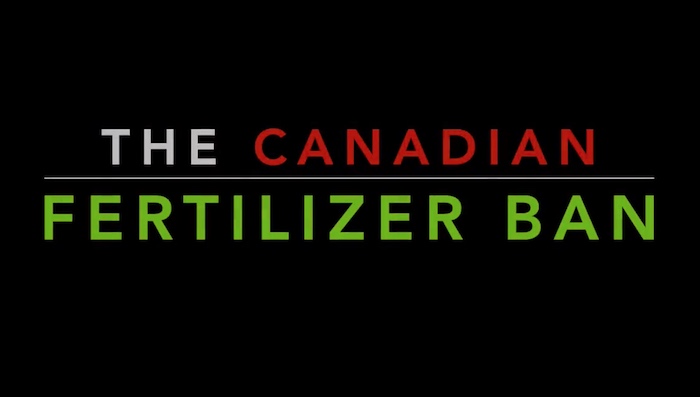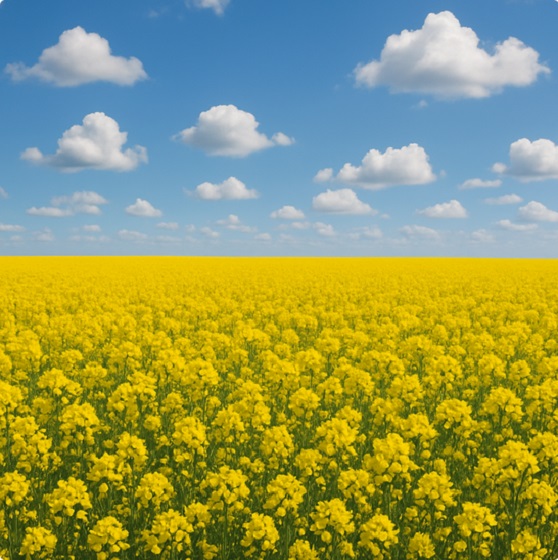Agriculture
Global food shortage? So what! Governments want to reduce the use of fertilizer anyway

Once we acknowledge that over 80% of Canadians live in cities (and an even larger percentage seemingly don’t care much about poor people) it’s much easier to understand why the average Canadian isn’t far more upset with the government’s plan to coerce farmers to cut back on nitrogen fertilizer (otherwise known as plant food).
As complex as the formulas are for estimating the amount of pollution caused by fertilizer use, there’s actually a very simple way to understand this initiative. So let’s simplify. In order to help reduce Canada’s share (about 1%) of global emissions (which a ton of scientists swear is making the world hotter.. Sorry not hotter.. but more climate changy…which actually somehow means worse for everyone everywhere) the government is strongly urging farmers to use less fertilizer and thereby produce less food. The federal government estimates farming is responsible for about 10% of Canada’s emissions. Now that’s all aspects of farming including everything from using nitrogen fertilizer, to driving tractors, to presumably the horrible practice farmers share of breathing out every couple of seconds (more when they’re working hard). They estimate nitrogen fertilizer is responsible for about 18% of the emissions from farming (see below). In other words, this has to stop! I mean 18% of 10% of 1%.. how did we let this get so far away on us?
But here’s a question. Why would a farmer (who is a business operator) want to produce less food (which is the product farmers make and sell to feed the world)? Until now, farmers have always taken pride in producing the best possible crops using the lowest possible inputs (all the expenses from gas to seed to fertilizer, etc). Who wouldn’t? It’s how they make their money. Sounds like a tough sell. Perhaps that’s why governments are coming out with programs that will pay farmers not to farm quite so much. Right here in Alberta there’s a program that could pay an individual farmer up to $75,000.00 to cut back and be a better producer (government talk for producing less food) for people (not poor people who may starve in the coming months) fortunate enough to live 100 years from now.
Sure. That may sound a little offside when you consider global food shortages (another term for starving people) are expected to increase drastically in the coming months. You see the world is always somewhere between a little short of food and desperately short of food (depending on where you live you might feel more ‘desperate’ than inconvenienced). A simple minded person like myself might say “Why would we mess with this system that is feeding more people successfully than at any other time in world history?” Silly me. These guys are way beyond that simple thinking. That’s why the government isn’t asking farmers to consider what’s happening in the world right now (8 billion people need to eat). The government is asking farmers to consider what ‘might’ happen sometime in the future (it may sound a bit wacky when we say it out loud, but we’re pretty sure we can stop the climate from changing).
Apparently in order to get the climate under our control, we should be OK if we have to sacrifice a few million (or multiple hundred million) eaters (another word for people) in the next few years (could be starting in the next few months).
Relax Canadians. We can continue to fly across the country to go surfing in honour of the National Day for Truth and Reconciliation (I saw you there on the beach didn’t I?). We’re almost surely not going to miss a meal. Yah, we might have to double or triple down at the grocery store, but just think of that perfect summer day in the future! You’ll be so happy when your child gleefully watches your grandchild in their paper swim suit splash away in the wooden baby pool that’s in the driveway where the car used to be out front of the rental (now that we won’t be allowed to own cars anymore there’s going to be so much more room in our driveways!) Too bad you can’t travel to be there in person because you’re still getting that ESG score back up after that trip to see the kids a couple years back. Too bad you can’t use that cool social media app to see what they posted because you accidentally typed Turdo instead of Trudeau six months ago (stupid spellcheck).
Here’s to a bright future without the constant worry of oil and gas and nitrogen fertilizer! Just think. No more storms. No more pesky record high or low temperatures. And water levels remain constant year in and year out. It’s going to be awesome (for all the descendants of the people who get to eat in the next couple of years). Maybe we’ll build a statue to honour today’s fearless leaders who are so smart they have realized that it’s NOT THEIR JOB TO PROTECT THE PEOPLE WHO VOTE FOR THEM TODAY, but to CREATE A BETTER FUTURE FOR THE DESCENDANTS OF THOSE WHO CAN AFFORD TO SURVIVE in the future! We’ll certainly inscribe it with something like “These guys weren’t afraid to crack a few eggs to make this omelette. Hope you enjoy omelettes!” I think the perfect location to put that statue will be Davos. I hear it’s beautiful. Speaking of omelettes I hope there are still chickens in the future. I understand those little runts like farting as much as cows do and don’t kid yourself, it adds up!
I digress. This isn’t all about my wandering thoughts. As a journalistic endeavour I’d like to present both sides of thinking on this initiative. This should help teach those simple farmers and their university educated consultants how to farm better with less fertilizer and more crop rotation, etc. (I’m still amazed farmers didn’t already figure this out for themselves, but I bow to those worldly thinkers who make these plans on “our” behalf.) Anyway, a few thoughts from Agriculture Canada, followed by an informative (and entertaining) video presentation from a very well known Saskatchewan farmer.
—–
These statements have been pulled from the “Discussion Document: Reducing emissions arising from the application of fertilizer in Canada’s agriculture sector” on the federal government’s website. You can read it all here but I’ve pulled a couple of statements to help explain the brilliant future forward thinking that goes into plans like this. So please read about why our governments are telling farmers to grow less food to feed fewer people at a time of food shortages.
” In December 2020, the Government of Canada announced its Strengthened Climate Plan, “A Healthy Environment and a Healthy Economy.” It includes a number of measures affecting the agriculture sector, with a goal to reduce greenhouse gas (GHG) emissions, and increase carbon sequestration. This discussion paper addresses one of these measures: a national target to reduce absolute levels of GHG emissions arising from fertilizer application by 30% below 2020 levels by 2030.
Background
Agriculture was responsible for approximately 10% of Canada’s GHG emissions in 2019, or 73 Mt CO2, which come from three main sources: enteric fermentation (24Mt), crop production (24Mt) , and on-farm fuel use (14Mt) (National Inventory Report, 2021.) Based on current data for 2019, emissions from synthetic fertilizers accounted for 12.75 Mt. While many players in the agriculture sector are already working to improve nutrient management and reduce emissions associated with crop production, fertilizers are responsible for a growing share of overall agricultural emissions.
Since the release of Canada’s Strengthened Climate Plan, the Government of Canada has moved swiftly to implement its key aspects in order to create jobs, grow the economy and protect the planet. In April 2021, in line with its obligations under the Paris Agreement, the Government of Canada announced a new GHG emissions reduction target of 40-45% below 2005 levels by 2030. This target, along with other developments such as the passage of the Canadian Net Zero Emissions Accountability Act, which enshrines in legislation Canada’s commitment to achieve net-zero emissions across the Canadian economy by 2050, highlights the need to reduce absolute GHG emissions across all economic sectors, including agriculture.
—–
This part is really interesting because it shows how fertilizer use is far more intense in Quebec and the Maritime provinces, though the bulk of the reductions will have to take place in Western Canada anyway. You know, because.. even though western farmers use less, there are more of them so they actually use more, plus they’re farther away from Ottawa and have less representation per capita.. what was I saying?
Regional Variations
Fertilizer induced emissions are not spatially or temporally uniform across Canadian agricultural landscapes. The seasonal pattern of N2O emissions reflects the interaction between soil temperature, soil water and nitrate availability. Drier regions of the Prairies have much lower N2O losses than the moister regions of Eastern Canada. N2O emissions per hectare are greater in Eastern Canada as a result of the wetter climate and greater N application rates. However, the much larger land area in the Prairies vs. Eastern Canada results in greater total N fertilizer application in the Prairies and thus the total emissions are much higher in this region.
It is important to note that the strategies required to achieve the 30% N2O emission reduction objective will vary across the country as the emissions reduction potential is impacted by biophysical factors (soil type, soil humidity, climate), crop types, and climate change impacts.Footnote3 (OH DEAR GOD CLIMATE CHANGE IS CAUSING MORE CLIMATE CHANGE!)
Figure 3 illustrates the differences between the fertilizer induced emissions patterns across the country, showing N2O emissions per hectare in 2018. The intensity of fertilizer emissions (emissions per ha) is higher east of Saskatchewan, indicating that more fertilizer is applied per hectare, resulting in more direct emissions on a per-acre basis. In addition, wetter conditions in the East result in more direct and indirect emissions.

—–
This part clearly explains how regions that use less fertilizer may be asked to cut back even more than regions using a lot more per capita, because.. because. Also it encourages farmers to stop the nasty habit of pouring fertilizer out randomly all over the place and then grabing a pinch and throwing it over their shoulder. For some reason it still hasn’t addressed when farmers (and their family members) exhale, which is also more intense in heavily populated urban areas in the east (likely because it’s not N2O, but CO2).
Objectives of the National Target for Fertilizer Emissions
In order to achieve a concrete reduction in overall emissions, the target is established relative to absolute emissions rather than emissions intensity. The Government of Canada has been clear that the objective of the national target for fertilizers is to reduce emissions, and that the primary method to achieve this is not to establish a mandatory reduction in fertilizer use that isn’t linked to improved efficiency and maintaining or improving yields. Rather, the goal is to maximize efficiency, optimize fertilizer use, encourage innovation, and to work collaboratively with the agriculture sector, partners and stakeholders in identifying opportunities that will allow us to successfully reach this target.
—–
OK. I don’t expect you were able to understand most of that. But they did their best to explain to those of us who aren’t as good as planning future world scenarios as they are. Now that you see the way our fearless leaders think. But what about the rest of us? In the interest of journalistic integrity we’ll show you what one simple farmer thinks of being urged to use less fertilizer. If you haven’t seen QDM before, please note he sometimes uses very descriptive adjectives (sometimes he turns them into verbs and nouns too) which might be a tad harsh for the younger folk. Please enjoy with a grain of salt and a malted beverage. When he’s finished you can decide for yourself whether you think it’s a great idea to cut back on food production by using less fertilizer.
Agriculture
Bovaer Backlash Update: Danish Farmers Get Green Light to Opt Out as UK Arla Trial Abruptly Ends!

In a pivotal shift, Denmark’s Veterinary and Food Administration has issued new guidance: Farmers can immediately suspend Bovaer administration if they “suspect” it poses risks to herd health. On the heels of the Danish announcement—the major UK trial of Bovaer on 30 Arla Foods farms has abruptly ended amid health fears.
The Mandate Cracks: Farmers Given the Green Light to Opt Out
On November 5, 2025, Denmark’s Fødevarestyrelsen (Danish Veterinary and Food Administration) issued a press release and accompanying guidance clarified that farmers (specifically the herd manager, or besætningsansvarlige) could immediately exempt individual cows or entire herds from the mandatory Bovaer use if they suspected it was causing or exacerbating health issues, prioritizing animal welfare under existing regulations.
Sonia Elijah investigates is a reader-supported publication.
To receive new posts and support my work, consider becoming a free or paid subscriber.
This was in response to surging reports of cow illnesses since October 1, where farms with over 50 cows have been mandated to use the synthetic additive, Bovaer (containing 3-nitrooxypropanol), developed by DSM-Firmenich. If the farms do not comply, they face heavy fines.
Bovaer Backlash: Danish Cows Collapsing Under Mandatory Methane-Reducing Additive |
||||||
|
||||||
| Article updated: November 4 | ||||||
|
The guidance emphasized that exemptions apply to cases of feed-related metabolic disorders (e.g., fatty liver, milk fever, or rumen issues) and require documentation via a “tro- og loveerklæring” (declaration of good faith) on LandbrugsInfo, with veterinary consultation recommended for severe cases. No fines would apply for such welfare-based pauses, though farmers must still meet methane reduction goals via alternatives like increased feed fat. This effectively gave the “green light” for opting out on welfare grounds.
Reports surged of Danish dairy farmers unilaterally halting Bovaer administration, accusing the government of “poisoning” livestock to meet climate targets.
A November 3, 2025, article in LandbrugsAvisen (Denmark’s leading agricultural newspaper), quoted veterinarian Torben Bennedsgaard from BoviCura (a specialized cattle health advisory service closely tied to Danish dairy producers). He stated: “Every other farmer has problems with Bovaer.”
“Bovaer is a proven, effective and safe solution”
A spokesperson for DSM-Firmenich, the company that developed Bovaer, told Agriland, that “animal welfare is our highest priority”. They went on to state: “We are actively engaging with the relevant organisations to ensure that all these concerns are fully investigated and properly addressed..In previously reported cases, Bovaer was not identified as a contributing factor to the health concerns raised…Bovaer is a proven, effective and safe solution that has been successfully used for over three years by thousands of farmers in over 25 countries.”
UK Ripple Effects: Arla Trial Abruptly Halted
On 7 November, the BBC reported that the major UK trial of Bovaer on 30 Arla Foods farms concluded earlier than planned amid “farmer health concerns” for cows, echoing Danish reports. It stated: ‘Bovaer is now the focus of an investigation in Denmark after farmers raised fresh concerns but manufacturer DSM-Firmenich said the additive was “proven, effective and safe.”’
Arla, which supplies major retailers like Tesco and Aldi, is now reviewing data before deciding on wider rollout. The trial aimed to cut methane by 30% but faced criticism for lacking transparency on animal impact.
Jannik Elmegaard, of the Danish Food and Veterinary Administration, told the BBC: “They very aware that some herd owners have reported animals showing signs of illness after being fed with Bovaer” but it was “unclear how many cows were affected”.
Last year, I reported on the UK’s Arla trial—whilst digging through various safety assessment reports on Bovaer, I came across several troubling findings and anomalies.
BREAKING: Methane-Reducing Feed Additive Trialled in Arla Dairy Farms |
||||||
|
||||||
| On November 26th, Arla Foods Ltd. announced via social media their collaboration with major UK supermarkets like Tesco, Aldi, and Morrisons to trial Bovaer, a feed additive, aiming to reduce methane … | ||||||
|
In a public rebuttal, Frank Mitloehner, Professor of Animal Science at UC Davis and Director of the Clarify Center for Enteric Fermentation Research, posted on X ”Hogwash!”—dismissing viral claims of Bovaer-related cow health issues in Denmark by highlighting his lab’s ongoing research and widespread U.S. usage data.
The green light in Denmark is not a mere victory—it’s a damning admission that the emperor’s new feed has holes big enough for a whole herd to escape through.
As Arla licks its wounds and DSM-Firmenich doubles down on “proven safe,” the real trial begins: can climate crusaders stomach the science when it bites back?
If you appreciate the hard work that I do as an independent investigative journalist,
please consider supporting me with a paid subscription.
Subscribe to Sonia Elijah Investigates
Agriculture
Farmers Take The Hit While Biofuel Companies Cash In

From the Frontier Centre for Public Policy
Canada’s emissions policy rewards biofuels but punishes the people who grow our food
In the global rush to decarbonize, agriculture faces a contradictory narrative: livestock emissions are condemned as climate threats, while the same crops turned into biofuels are praised as green solutions argues senior fellow Dr. Joseph Fournier. This double standard ignores the natural carbon cycle and the fossil-fuel foundations of modern farming, penalizing food producers while rewarding biofuel makers through skewed carbon accounting and misguided policy incentives.
In the rush to decarbonize our world, agriculture finds itself caught in a bizarre contradiction.
Policymakers and environmental advocates decry methane and carbon dioxide emissions from livestock digestion, respiration and manure decay, labelling them urgent climate threats. Yet they celebrate the same corn and canola crops when diverted to ethanol and biodiesel as heroic offsets against fossil fuels.
Biofuels are good, but food is bad.
This double standard isn’t just inconsistent—it backfires. It ignores the full life cycle of the agricultural sector’s methane and carbon dioxide emissions and the historical reality that modern farming’s productivity owes its existence to hydrocarbons. It’s time to confront these hypocrisies head-on, or we risk chasing illusory credits while penalizing the very system that feeds us.
Let’s take Canada as an example.
It’s estimated that our agriculture sector emits 69 megatonnes (Mt) of carbon dioxide equivalent (CO2e) annually, or 10 per cent of national totals. Around 35 Mt comes from livestock digestion and respiration, including methane produced during digestion and carbon dioxide released through breathing. Manure composting adds another 12 Mt through methane and nitrous oxide.
Even crop residue decomposition is counted in emissions estimates.
Animal digestion and respiration, including burping and flatulence, and the composting of their waste are treated as industrial-scale pollutants.
These aren’t fossil emissions—they’re part of the natural carbon cycle, where last year’s stover or straw returns to the atmosphere after feeding soil life. Yet under United Nations Intergovernmental Panel on Climate Change (IPCC) guidelines adopted by Canada, they’re lumped into “agricultural sources,” making farmers look like climate offenders for doing their job.
Ironically, only 21 per cent—about 14 Mt—of the sector’s emissions come from actual fossil fuel use on the farm.
This inconsistency becomes even more apparent in the case of biofuels.
Feed the corn to cows, and its digestive gases count as a planetary liability. Turn it into ethanol, and suddenly it’s an offset.
Canada’s Clean Fuel Regulations (CFR) mandate a 15 per cent CO2e intensity drop by 2030 using biofuels. In this program, biofuel producers earn offset credits per litre, which become a major part of their revenue, alongside fuel sales.
Critics argue the CFR is essentially a second carbon tax, expected to add up to 17 cents per litre at the pump by 2030, with no consumer rebate this time.
But here’s the rub: crop residue emits carbon dioxide, methane and nitrous oxide whether the grain goes to fuel or food.
Diverting crops to biofuels doesn’t erase these emissions: it just shifts the accounting, rewarding biofuel producers with credits while farmers and ranchers take the emissions hit.
These aren’t theoretical concerns: they’re baked into policy.
If ethanol and biodiesel truly offset emissions, why penalize the same crops when used to feed livestock?
And why penalize farmers for crop residue decomposition while ignoring the emissions from rotting leaves, trees and grass in nature?
This contradiction stems from flawed assumptions and bad math.
Fossil fuels are often blamed, while the agricultural sector’s natural carbon loop is treated like a threat. Policy seems more interested in pinning blame than in understanding how food systems actually work.
This disconnect isn’t new—it’s embedded in the history of agriculture.
Since the Industrial Revolution, mechanization and hydrocarbons have driven abundance. The seed drill and reaper slashed labour needs. Tractors replaced horses, boosting output and reducing the workforce.
Yields exploded with synthetic fertilizers produced from methane and other hydrocarbons.
For every farm worker replaced, a barrel of oil stepped in.
A single modern tractor holds the energy equivalent of 50 to 100 barrels of oil, powering ploughing, planting and harvesting that once relied on sweat and oxen.
We’ve traded human labour for hydrocarbons, feeding billions in the process.
Biofuel offsets claim to reduce this dependence. But by subsidizing crop diversion, they deepen it; more corn for ethanol means more diesel for tractors.
It’s a policy trap: vilify farmers to fund green incentives, all while ignoring the fact that oil props up the table we eat from.
Policymakers must scrap the double standards, adopt full-cycle biogenic accounting, and invest in truly regenerative technologies or lift the emissions burden off farmers entirely.
Dr. Joseph Fournier is a senior fellow at the Frontier Centre for Public Policy. An accomplished scientist and former energy executive, he holds graduate training in chemical physics and has written more than 100 articles on energy, environment and climate science.
-

 armed forces2 days ago
armed forces2 days agoIt’s time for Canada to remember, the heroes of Kapyong
-

 Digital ID2 days ago
Digital ID2 days agoCanada moves forward with digital identification for federal benefits seekers
-

 Daily Caller1 day ago
Daily Caller1 day agoUS Nuclear Bomber Fleet Shares Fence With Trailer Park Linked To Chinese Intel-Tied Fraudster
-

 Alberta2 days ago
Alberta2 days agoSchool defunding petition in Alberta is a warning to parents
-

 espionage1 day ago
espionage1 day agoChinese-Owned Trailer Park Beside U.S. Stealth Bomber Base Linked to Alleged Vancouver Repression Case
-

 Daily Caller1 day ago
Daily Caller1 day agoLaura Ingraham Presses Trump On Allowing Flood Of Chinese Students Into US
-

 Business2 days ago
Business2 days agoLiberals refuse to disclose the amount of taxpayer dollars headed to LGBT projects in foreign countries
-

 Environment1 day ago
Environment1 day agoThe Myths We’re Told About Climate Change | Michael Shellenberger














